
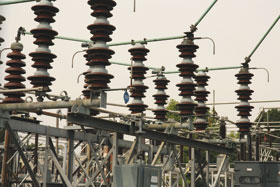
Attacks on transformer substations and other components of the electrical grid in North America have underscored the risks associated with physical security breaches and the potentially disastrous consequences. Recent events such as the shooting at the Metcalf transmission substation in California have brought a new sense of urgency around the issue of grid security. With tens of thousands of substations across the US situated in locations that range from isolated remote areas to densely populated urban areas, the job of securing these critical assets is challenging at best.
In light of the ongoing threat to the power grid, and to ensure greater physical security around substations, in March 2014, the Federal Energy Regulatory Commission (FERC) ordered the North American Energy Reliability Corporation (NERC) to establish Critical Infrastructure Protection (CIP) standards that ‘address physical security risks and vulnerabilities related to the reliable operation’ of the bulk power system.1 In response, on May 13 2014, the NERC Board of Trustees filed its proposed CIP-014 physical security standard for critical components of the power grid. Once officially adopted, CIP-014 will serve as a blueprint to help both utilities and security professionals understand the requirements to best protect these vital assets.
While the threat of terrorist activity to disrupt the power grid remains ever-present, other hazards such as theft and vandalism are more common and represent an additional challenge. With the price of copper at an all-time high, and with a large amount of copper wiring present at electrical substations, it’s no surprise that they have become an attractive target – often with lethal consequences, along with the associated liability beyond potentially disrupting services. Even if thieves get away unscathed, the safety of the substation may have been compromised. Utility employees have been severely injured or killed in the process of performing regular maintenance due to the destabilisation of certain elements of the power grid caused by copper theft breaches that went undetected.
Clearly, the need for reliable intrusion detection systems to protect electrical assets has never been higher.
This white paper, intended for electrical transmission owners and security professionals who manage and implement security solutions, addresses these difficulties and offers commonsense advice to protect substation assets effectively and affordably, while meeting several key requirements of the NERC guidelines.
Understanding NERC CIP-014 guidelines
CIP-014 is specifically focused on protecting the nation’s electric transmission stations and substations from physical attack. Following CIP-014’s finalisation, utilities will be tasked to identify their most critical facilities – those that if damaged or taken offline would ‘result in widespread instability, uncontrolled separation or cascading within an interconnection,’2 and then ‘develop, validate and implement plans to protect against physical attacks that may compromise the operability or recovery’3 of these facilities.
To comply, utilities will need to perform a security analysis to evaluate potential threats and vulnerabilities of physical attacks on the targets they’ve identified as most critical, verify this risk assessment with an unaffiliated third party, and then deploy and implement physical security plans to cover those locations. Finally, utilities will undergo another third-party review to evaluate their vulnerability analysis and physical security plans. These requirements will be implemented in phases, giving utilities time to prepare for and implement physical security upgrades.
Importantly, CIP-014 does not prescribe specific solutions that utilities should deploy; instead, it provides suggested guidance and practices that can help mitigate risks. The concepts as outlined in the NERC standards also represent a sound and effective security practice that suits all facilities tasked with protecting key assets in the outdoors.
For example, in order to assure the physical security of these potentially vulnerable substations, NERC suggests implementing a ‘systems approach’ comprising six specific concepts, which are summarised as Deter, Detect, Delay, Assess, Communicate and Respond.4 NERC also suggests a ‘Defence in Depth’ approach that attempts to ‘prevent the advance of an attacker,’ using zones of protection over a larger area, which creates an opportunity to respond to an event over time, rather than setting up a ‘single, strong defensive line.’5 These layers of protection can start with the perimeter fence and extend into sensitive internal areas such as control rooms or copper storage locations.
The NERC guidelines acknowledge that the best approach can be complicated by the many options available to achieve these goals. Let’s look at how one particular technology, smart thermal intrusion detection cameras, contributes to substation security while satisfying many of CIP-014’s security recommendations.
Meeting NERC guidelines with smart thermal detection solutions
Safeguarding any outdoor asset, whether airport perimeters, oil refineries, chemical plants or electrical substations often comes down to the same thing: Accurate detection and timely information about the unfolding event. While there are many strategies for detecting outdoor intrusions, and various approaches for meeting CIP-014, combining reliable alerts with knowledge about what is actually happening and where it is happening is the ultimate goal.
While video surveillance cameras based on visible light have long been established as an effective forensic tool for analysing what happened after an event, there are limitations to what video surveillance can do. Historically, it has only provided passive recording of events for future use. Critical asset protection demands that intruders are detected as soon as they enter a secured area. Such real-time awareness is critical to ensuring a timely response and preventing an incident from escalating.
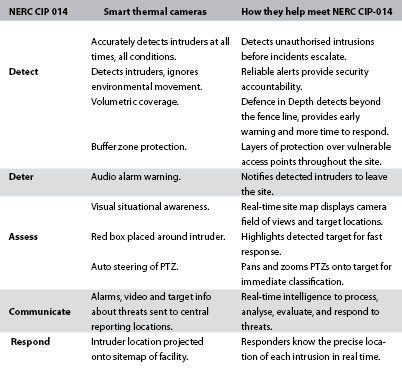
As a result, thermal technology has become a top choice for detecting intrusions outdoors. These systems, which combine thermal sensors with video analytics, are known as ‘smart’ thermal cameras because they never tire, can cover large areas, and 'see' what the human eye would miss, while people – when provided with accurate alerts that thermal cameras generate – can make appropriate response decisions.
Using smart thermal cameras for perimeter security applications was once seen as a more costly solution better suited for government or military applications. Recent developments in thermal camera technology provide a new level of detection accuracy while making them available at commercial prices. Smart thermal cameras have benefited from the same processing advancements that make all modern computing devices so powerful, and use this processing to amplify small differences between the temperature of a person and the background, accurately detecting intruders even in less than ideal conditions. They ignore headlights, reflections off water, or other lighting issues that cause false detections with visible light cameras. The combination of higher performance and lower costs is rapidly expanding the use of thermal cameras for 24/7 security applications.
Let’s take a look at how smart thermal camera systems contribute to substation security in general and CIP-014 compliance in particular.
Dependability of alerts
Solutions deployed to protect critical facilities, like transmission substations, must be able to detect the presence of unauthorised persons anywhere across site perimeters and outdoor areas at all times. Excessive nuisance alarms cause operators to lose trust in the system when an alert occurs, reducing accountability across the security function.
Dependable alerts are the cornerstone to effective security; operators must know that when an alarm is received, it’s time to respond. Smart thermal cameras can provide accurate detection over large areas, regardless of the outdoor conditions. For example, video processing within the camera can be used to stabilise images electronically before video analytics are invoked. This approach removes camera motion from wind or vibrations as a source of nuisance alarms. Smart thermal cameras that use GPS-based video analytics ignore the movement of small animals, trash blowing across the ground, and other non-threatening movement from causing alerts, and send alarms only when human intruders enter secure areas.
Protection in depth
The NERC standards recognise that early and accurate detection is essential to achieve a high level of vigilance. For this reason, NERC seeks to create zones of protection beyond the fence line and internally around areas of heightened security. Such buffer zones create additional time to respond before site assets are harmed. Numerous technologies can provide early detection of a perimeter security breach but smart cameras provide the added benefit of visual evidence of a breach without need for additional verification systems, saving valuable response time. See Figure 1.
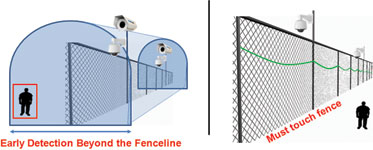
Traditionally, the common approach for securing large outdoor areas has been to use a ‘blind’ sensor, such as coax or fibre on the fence, acting as an activity detector, augmented by a camera to help security guards determine the cause of the alert. One drawback to such an approach is that these systems fail to address CIP-014 best practices to deliver an early warning and an opportunity for a rapid response. Another drawback to such fence-mounted systems is that they are prone to a very high rate of nuisance alerts. At the same time, costs for deploying and maintaining two separate systems – a sensor and a video system – can quickly escalate.
A better approach is to implement a volumetric system to provide early warning, which is both NERC’s preference and an outdoor security best practice. This is where smart thermal cameras excel. These volumetric systems detect people and objects beyond the fence line of a substation, triggering alarms when intruders approach the facility, giving security personnel ample warning and time to intervene.
For higher-risk transmission stations, smart thermal cameras can be combined with fence-mounted sensors which act as a secondary layer of security.
Situational awareness
The goal for any security organisation is to maintain awareness of the risks that are lurking and quickly obtain reliable information about the place and nature of an intrusion. Achieving security awareness depends on knowing the precise location and nature of an intrusion. Smart thermal cameras meet these goals when they are geo-registered.
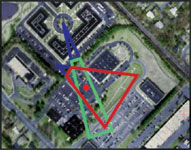
Geo-registration, which means that the camera’s field of view (FOV) maps the GPS coordinates of all points in the landscape under surveillance, unlocks key situational awareness benefits: See Figure 2.
Real-time target location
Physical Security Information Management (PSIM) software can use the target location data to display the topological positions of detected objects, overlaid on a top-down map of the surveillance area.
Auto-steer PTZ cameras: PTZ cameras are often used to watch outdoor areas, but when applied to large areas, trying to use a PTZ camera’s narrow view to find targets manually almost guarantees that events will go unnoticed. GPS information about detected targets can be used to automatically direct PTZ cameras to the exact location of an alarm to zoom and follow an intrusion in real-time, allowing security operators to quickly assess the nature of the alarm, and react appropriately. See Figure 3.
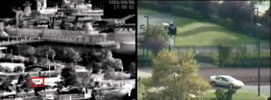
Layers of protection
Compliance with CIP-014 requires securing both perimeter and multiple sensitive areas and access points throughout the facility. Smart thermal video is a good tool to protect internal assets where physical or man-made boundaries are unlikely to exist. Adding infrastructure around sensitive areas would be costly and likely impede the flow of business operations. Smart video can be used to create a buffer zone around areas of special concern to control access based on time of day or other criteria, mitigating possible sabotage or theft from insiders.
The GPS-based analytics built into some smart thermal cameras play an important role here as well. Utilities can create multiple security zones where alerts are only triggered if an intruder is moving in a certain direction that might indicate a threat, such as toward a fence. If that same intruder climbed over the fence and reached the inside yard, another security zone can be created that sends an additional alert for another area.
Affordability
While NERC does not directly address system costs, the reality of business operations makes doing so a requirement. Smart thermal cameras can detect intruders 600 metres away, and an area as wide as 60 metres. Using such long-detection reduces the number of cameras needed, along with reduced infrastructure and construction costs.
Conclusion
As defined in the NERC guidelines, the goal for protecting critical substation assets is to employ technology that can “provide situational awareness of activity” about potential threat so that the utility can “initiate an appropriate and timely response.”6 Technologies such as smart thermal video are expanding the capabilities of perimeter security systems and taking their place alongside legacy strategies such as physical barriers and other forms of perimeter sensors, detecting intruders with high reliability and at low costs in the outdoors, helping utilities achieve the real-time response that CIP-014 requires.
Why use thermal for outdoor security
Video analytics used for security applications are based on detection, and the alert must be accurate. Outdoors, it’s almost impossible to achieve detection accuracy with a visible camera, and the reason is lighting.
Thermal cameras ‘see’ heat rather than light, so they are perfect ‘human detectors’ under all conditions, from zero light to bright sun, in rain, snow or humidity. They ignore all the movement that will cause alerts with visible cameras, like headlights and reflections off water. Thermal cameras also eliminate the expense, power and difficulty of lighting large outdoor perimeters.
Under almost all conditions, visible cameras are not a reliable, cost-effective detection system outdoors.
Best practice tools
SightSurvey
SightLogix has developed a patented Web-based tool called SightSurvey for designing a perimeter security system on your actual site. SightSurvey can ensure that blind spots are covered, help with lens selection and determine inbound detection ranges so you have 100% coverage.
Learn more: sightlogix.com/sightsurvey/
SightLogix Design Centre
SightLogix offers a no-cost Design Support Centre to walk security professionals through the various issues that arise when planning a perimeter security layout and apply technology in the most successful manner.
Learn more: sightlogix.com/design-support/
Information and resources
• To perform an online perimeter security design of your facility in minutes, visit: http://www.sightlogix.com/sightsurvey-tool
• To request design support, visit http://www.sightlogix.com/design-support
• To speak with a solution specialist, e-mail info@sightlogix.com or call +1 609 951 0008.
This white paper has been shortened, to read the full article go to www.sightlogix.com/substation-security-whitepaper/
© Technews Publishing (Pty) Ltd. | All Rights Reserved.